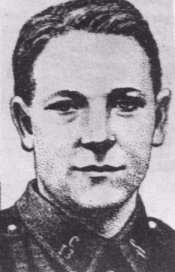John Croak
John Bernard Croak VC (May 18, 1892 – August 8, 1918) was a soldier in the Canadian Expeditionary Force during the First World War and posthumous recipient of the Victoria Cross, the highest and most prestigious award for gallantry "in the face of the enemy" that can be awarded to British and Commonwealth forces. He earned the award for events that occurred during the Battle of Amiens in August 1918. A park and elementary school was named in his memory at Glace Bay, Nova Scotia.
John Croak | |
|---|---|
 | |
| Born | 18 May 1882 Little Bay, Newfoundland |
| Died | 8 August 1918 (aged 36) † Hangard Wood, France |
| Buried | Hangard Wood British Cemetery, France |
| Allegiance | Canada |
| Years of service | 1915 – 1918 |
| Rank | Private |
| Unit | 13th (Royal Highlanders of Canada) Battalion, Canadian Expeditionary Force |
| Battles/wars | World War I |
| Awards | Victoria Cross |
Early life
Croak[Note 1] was born in Little Bay in Newfoundland, on May 18, 1892 to James and Cecelia Croak. The family moved to Glace Bay, Nova Scotia when Croak was two years old. He attended school there and then, at the age of 14, began work as a coal miner.[1]
First World War
In 1915, Croak enlisted in the Canadian Army and volunteered for service abroad with the Canadian Expeditionary Force. Posted to the 55th Battalion as a private, he embarked for Europe in November 1915. He soon transferred to the 13th Battalion, which was serving on the Western Front as part of 3rd Brigade, 1st Canadian Division. Through 1917 and the early part of 1918, Croak participated in several engagements as part of 13th Battalion; these included the Battles of Vimy Ridge, Hill 70 and Passchendaele.[1]
On 8 August 1918, the opening day of the Battle of Amiens, and the beginning of the Hundred Days Offensive, the 3rd Brigade, accompanied by a battalion of tanks, was at the forefront of the 1st Division's advance. The 13th Battalion became held up by machine gun posts in the vicinity of Hangard Wood. Croak attacked a machine gun post and took several prisoners whom he escorted to his company headquarters. Ignoring instructions to seek medical treatment for a wound to his arm, he carried out an attack on another machine gun post nearby. He was wounded again, this time fatally, in the act, and died that same day. He was recognised for his actions with an award of the Victoria Cross (VC).[2][Note 2] The VC, instituted in 1856, was the highest award for valour that could be bestowed on a soldier of the British Empire.[4] The citation for Croak's VC read:
For most conspicuous bravery in attack when having become separated from his section he encountered a machine gun nest, which he bombed and silenced, taking the gun and crew prisoners. Shortly afterwards he was severely wounded, but refused to desist. Having rejoined his platoon, a very strong point, containing several machine guns, was encountered. Private Croak, however, seeing an opportunity, dashed forward alone and was almost immediately followed by the remainder of the platoon in a brilliant charge. He was the first to arrive at the trench line, into which he led his men, capturing three machine guns and bayonetting or capturing the entire garrison. The perseverance and valour of this gallant soldier, who was again severely wounded, and died of his wounds, were an inspiring example to all.
— The London Gazette, No. 30922, September 24, 1918[5]
Croak is buried at Hangard Wood British Cemetery,[6] which is located 12 miles south west of Albert.[7] His VC, the first to be awarded to a soldier born in Newfoundland,[8] was presented to his mother at Government House in Halifax by MacCallum Grant, the Lieutenant Governor of Nova Scotia, on 23 November 1918.[9]
In Glace Bay, where Croak grew up, there is both a school and a Royal Canadian Legion named in his honor. There is also a park, located on the site of his former workplace, the Dominion No. 2 Colliery, named for him as well. In 1992, the park was the scene of the unveiling of a memorial plaque, made of Cape Breton rock, to Croak.[10]
The medal
In 1972 Croak's medals, which included the British War Medal and the Victory Medal in addition to the VC, were gifted by his nephew to the Army Museum at the Citadel in Halifax, Nova Scotia. The medals are now displayed at the Canadian War Museum.[11]
Notes
Footnotes
- The Newfoundland spelling of his surname is "Croke," but he preferred "Croak".[1]
- Lance Sergeant Herman Good (29 November 1887 – 18 April 1969), another soldier of 13th Battalion, was also awarded the VC for his actions at Hangard Wood.[3]
Citations
- Gliddon 2014, p. 23.
- Gliddon 2014, pp. 15–17.
- Gliddon 2014, p. 17.
- Ashcroft 2007, pp. 8–10.
- "No. 30922". The London Gazette (Supplement). 27 September 1918. p. 11430.
- "Croak, John Bernard". Commonwealth War Graves Commission. Retrieved 20 May 2018.
- "Hangard Wood British Cemetery". Commonwealth War Graves Commission. Retrieved 20 May 2018.
- Gliddon 2014, p. 21.
- Gliddon 2014, p. 22.
- Gliddon 2014, pp. 23–24.
- Gliddon 2014, p. 24.
References
- Ashcroft, Michael (2007) [2006]. Victoria Cross Heroes. London, United Kingdom: Headline Review. ISBN 978-0-7553-1633-5.CS1 maint: ref=harv (link)
- Gliddon, Gerald (2014) [2000]. The Final Days 1918. VCs of the First World War. Stroud, Gloucestershire: History Press. ISBN 978-0-7509-5368-9.CS1 maint: ref=harv (link)
External links
- John Bernard Croak's digitized service file
- Legion Magazine article on John Bernard Croak
- John Croak at Find a Grave
- Croak's Medals at the Canadian War Museum
- John Bernard Croak V.C. Memorial School info page
- John Bernard Croak V.C. Memorial School official page from Cape Breton-Victoria Regional School Board site